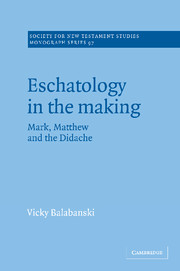Book contents
- Frontmatter
- Contents
- Preface
- List of abbreviations and note on texts
- Introduction
- 1 An imminent End? Models for understanding eschatological development in the first century
- 2 Matthew 25:1–13 as a window on eschatological change
- 3 Mark 13: eschatological expectation and the Jewish War
- 4 The Judean flight oracle (Mark 13:14ff) and the Pella flight tradition
- 5 Matthew 24: eschatological expectation after the Jewish War
- 6 Didache 16 as a development in Christian eschatology
- Conclusion
- Bibliography
- Index of modern authors
- Index of biblical and other ancient texts
- Subject index
2 - Matthew 25:1–13 as a window on eschatological change
Published online by Cambridge University Press: 04 September 2009
- Frontmatter
- Contents
- Preface
- List of abbreviations and note on texts
- Introduction
- 1 An imminent End? Models for understanding eschatological development in the first century
- 2 Matthew 25:1–13 as a window on eschatological change
- 3 Mark 13: eschatological expectation and the Jewish War
- 4 The Judean flight oracle (Mark 13:14ff) and the Pella flight tradition
- 5 Matthew 24: eschatological expectation after the Jewish War
- 6 Didache 16 as a development in Christian eschatology
- Conclusion
- Bibliography
- Index of modern authors
- Index of biblical and other ancient texts
- Subject index
Summary
The parable of the ten maidens is of particular interest with regard to the development of eschatology because of the motif of the delay of the bridegroom. As the parable stands, it is unique to Matthew's Gospel, though verses 11–12 show affinity to the Q material of Luke 13:25–7/Matt. 7:21–3. In order to ascertain the significance of this pericope for the current study, it is necessary to examine it exegetically and determine the Sitz im Leben of the traditions it represents. This is particularly necessary given the history of research on the synoptic parables, which has often studied them only for the access they give to the historical Jesus. E. Linnemann is correct in saying that our task is not to ‘regard what tradition has added to the parables as worthless wrapping material, which is thrown away as soon as we have unpacked the contents’.
The parable presents the reader with a number of problems or surprises:
(i) Lack of clarity as to where the ten maidens are as they wait for the bridegroom; do they fall asleep on the street?
(ii) Lateness of the beginning of the wedding feast;
(iii) The idea that the oil-sellers are open after midnight;
(iv) The harshness of the wise maidens towards the others in sending them off when they knew that the bridegroom was about to arrive;
(v) The relevance of the motif of sleep, which has no apparent bearing on the wisdom or foolishness of the maidens, yet links with the conclusion in verse 13;
(vi) Lack of mention of a bride.
- Type
- Chapter
- Information
- Eschatology in the MakingMark, Matthew and the Didache, pp. 24 - 54Publisher: Cambridge University PressPrint publication year: 1997

